Coupling Indoor and Outdoor Heat Stress During the Hot Summer of 2022: A Case Study of Freiburg, Germany
Abstract
1. Introduction
2. Materials and Methods
3. Results
3.1. Meteorological and Biometeorological Condition of Freiburg in Summer 2022
3.2. Thermal Comfort Conditions During Heat Waves
4. Discussion
4.1. Coupling Indoor and Outdoor Heat Stress
4.2. Characteristics Influencing Indoor Heat Stress
5. Conclusions
Author Contributions
Funding
Institutional Review Board Statement
Informed Consent Statement
Data Availability Statement
Conflicts of Interest
References
- Barriopedro, D.; Fischer, E.; Luterbacher, J.; Trigo, R.; García-Herrera, R. The hot summer of 2010: Redrawing the temperature record map of Europe. Science 2011, 332, 220–224. [Google Scholar] [CrossRef]
- Grumm, R. The central European and Russian heat event of July-August 2010. Bull. Am. Meteorol. Soc. 2011, 92, 1285–1296. [Google Scholar] [CrossRef]
- Hoy, A.; Hänsel, S.; Skalak, P.; Ustrnul, Z.; Bochníček, O. The extreme European summer of 2015 in a longterm perspective. Int. J. Clim. 2016, 37, 943–962. [Google Scholar] [CrossRef]
- Krzyżewska, A.; Dyer, J. The August 2015 mega-heatwave in Poland in the context of past events. Weather 2018, 73, 207–214. [Google Scholar] [CrossRef]
- Rahmstorf, S.; Coumou, D. Increase of extreme events in a warming world. Proc. Natl. Acad. Sci. USA 2011, 108, 17905–17909. [Google Scholar] [CrossRef]
- Rebetez, M.; Dupont, O.; Giroud, M. An analysis of the July 2006 heatwave extent in Europe compared to the record year of 2003. Theor. Appl. Climatol. 2009, 95, 1–7. [Google Scholar] [CrossRef]
- Rebetez, M.; Mayer, H.; Dupont, O.; Schindler, D.; Gartner, K.; Kropp, J.P.; Menzel, A. Heat and drought 2003 in Europe: A climate synthesis. Ann. For. Sci. 2006, 63, 569–577. [Google Scholar] [CrossRef]
- Shevchenko, O.; Snizhko, S.; Zapototskyi, S.; Matzarakis, A. Biometeorological Conditions during the August 2015 Mega-Heat Wave and the Summer 2010 Mega-HeatWave in Ukraine. Atmosphere 2022, 13, 99. [Google Scholar] [CrossRef]
- Shevchenko, O.; Snizhko, S.; Zapototskyi, S.; Svintsitska, H.; Matviienko, M.; Matzarakis, A. Long-term analysis of thermal comfort conditions during heat waves in Ukraine. Geogr. Pol. 2022, 95, 53–70. [Google Scholar] [CrossRef]
- Fouillet, A.; Rey, G.; Laurent, F.; Pavillon, G.; Bellec, S.; Guihenneuc-Jouyaux, C.; Clavel, J.; Jougla, E.; Hémon, D. Excess mortality related to the August 2003 heat wave in France. Int. Arch. Occup. Environ. Health 2006, 80, 16–24. [Google Scholar] [CrossRef]
- Laaidi, K.; Zeghnoun, A.; Dousset, B.; Bretin, P.; Vandentorren, S.; Giraudet, E.; Beaudeau, P. The Impact of Heat Islands on Mortality in Paris during the August 2003 Heat Wave. Environ. Health Perspect. 2012, 120, 254–259. [Google Scholar] [CrossRef]
- Výberči, D.; Labudová, L.; Eštóková, M.; Faško, P.; Trizna, M. Human mortality impacts of the 2015 summer heat spells in Slovakia. Theor. Appl. Climatol. 2018, 133, 925–936. [Google Scholar] [CrossRef]
- Urban, A.; Hanzlíková, H.; Kyselý, J.; Plavcová, E. Impacts of the 2015 Heat Waves on Mortality in the Czech Republic-A Comparison with Previous Heat Waves. Int. J. Environ. Res. Public Health 2017, 14, 1562. [Google Scholar] [CrossRef]
- Muthers, S.; Laschewski, G.; Matzarakis, A. The Summers 2003 and 2015 in South-West Germany: Heat Waves and Heat-Related Mortality in the Context of Climate Change. Atmosphere 2017, 8, 224. [Google Scholar] [CrossRef]
- Lu, R.; Xu, K.; Chen, R.; Chen, W.; Li, F.; Lv, C. Heat waves in summer 2022 and increasing concern regarding heat waves in general. Atmos. Ocean. Sci. Lett. 2022, 16, 100290. [Google Scholar] [CrossRef]
- Feser, F.; van Garderen, L.; Hansena, F. The Summer Heatwave 2022 over Western Europe: An Attribution to Anthropogenic Climate Change. Bull. Am. Meteorol. Soc. 2024, 105, E2175–E2179. [Google Scholar] [CrossRef]
- Copernicus Observer. 2022: OBSERVER: A Wrap-Up of Europe’s Summer 2022 Heatwave. Copernicus. Available online: https://www.copernicus.eu/en/news/news/observer-wrap-europes-summer-2022-heatwave (accessed on 4 January 2025).
- Ballester, J.; Quijal-Zamorano, M.; Méndez Turrubiates, R.F.; Pegenaute, F.; Herrmann, F.R.; Robine, J.M.; Basagana, X.; Tonne, C.; Anto, J.M.; Achebak, H. Heat-related mortality in Europe during the summer of 2022. Nat. Med. 2023, 29, 1857–1866. [Google Scholar] [CrossRef]
- Kim, J.-H.; Nam, S.-H.; Kim, M.-K.; Serrano-Notivoli, R.; Tejedor, E. The 2022 record-high heat waves over southwestern Europe and their underlying mechanism. Weather Clim. Extrem. 2024, 46, 100729. [Google Scholar] [CrossRef]
- Ibebuchi, C.C.; Abu, I.O. Characterization of temperature regimes in Western Europe, as regards the summer 2022 Western European heat wave. Clim. Dyn. 2023, 61, 3707–3720. [Google Scholar] [CrossRef]
- Cheung, S.S.; Lee, J.K.W.; Oksa, J. Thermal stress, human performance, and physical employment standards. Appl. Physiol. Nutr. Metab. 2016, 41 (Suppl. 2), S148–S164. [Google Scholar] [CrossRef]
- Katafygiotou, M.C.; Serghides, D.K. Thermal comfort of a typical secondary school building in Cyprus. Sustain. Cities Soc. 2014, 13, 303–312. [Google Scholar] [CrossRef]
- Zomorodian, Z.S.; Tahsildoost, M.; Hafezi, M. Thermal comfort in educational buildings: A review article. Renew. Sustain. Energy Rev. 2016, 59, 895–906. [Google Scholar] [CrossRef]
- Ruuhela, R.; Jylhä, K.; Lanki, T.; Tiittanen, P.; Matzarakis, A. Biometeorological Assessment of Mortality Related to Extreme Temperatures in Helsinki Region, Finland, 1972–2014. Int. J. Environ. Res. Public Health 2017, 14, 944. [Google Scholar] [CrossRef]
- Bunker, A.; Wildenhain, J.; Vandenbergh, A.; Henschke, N.; Rocklöv, J.; Hajat, S.; Sauerborn, R. Effects of Air Temperature on Climate-Sensitive Mortality and Morbidity Outcomes in the Elderly; a Systematic Review and Meta-analysis of Epidemiological Evidence. EBioMedicine 2016, 6, 258–268. [Google Scholar] [CrossRef]
- Hajat, S.; O’Connor, M.; Kosatsky, T. Health effects of hot weather: From awareness of risk factors to effective health protection. Lancet 2010, 37, 856–863. [Google Scholar] [CrossRef]
- Kovats, R.S.; Hajat, S. Heat stress and public health: A critical review. Annu. Rev. Public Health 2008, 29, 41–55. [Google Scholar] [CrossRef]
- Haslinda, M.K.; Kamsah, N.B.; Ghaleb, F.A.; Idrus-Alhamid, M. Enhancement of thermal comfort in a large space building. Alex. Eng. J. 2019, 58, 49–65. [Google Scholar] [CrossRef]
- Bueno, A.; De Paula Xavier, A.; Broday, E. Evaluating the Connection between Thermal Comfort and Productivity in Buildings: A Systematic Literature Review. Buildings 2021, 11, 244. [Google Scholar] [CrossRef]
- Pourshaghaghy, A.; Omidvari, M. Examination of thermal comfort in a hospital using PMV–PPD model. Appl. Ergon. 2012, 43, 1089–1095. [Google Scholar] [CrossRef]
- Calvino, F.; La Gennusa, M.; Morale, M.; Rizzo, G.; Scaccianoce, G. Comparing different control strategies for indoor thermal comfort aimed at the evaluation of the energy cost of quality of building. Appl. Therm. Eng. 2010, 30, 2386–2395. [Google Scholar] [CrossRef]
- Gallardo, A.; Palme, M.; Lobato-Cordero, A.; Beltrán, R.; Gaona, G. Evaluating Thermal Comfort in a Naturally Conditioned Office in a Temperate Climate Zone. Buildings 2016, 6, 27. [Google Scholar] [CrossRef]
- Marino, C.; Nucara, A.; Pietrafesa, M. Thermal comfort in indoor environment: Effect of the solar radiation on the radiant temperature asymmetry. Sol. Energy 2017, 144, 295–309. [Google Scholar] [CrossRef]
- Reis, I.F.G.; Figueiredo, A.; Samagaio, A. Modeling the Evolution of Construction Solutions in Residential Buildings’ Thermal Comfort. Appl. Sci. 2021, 11, 2427. [Google Scholar] [CrossRef]
- Jowkar, M.; Montazami, A. Thermal Comfort in the UK Higher Educational Buildings: The Influence of Thermal History on Students’ Thermal Comfort. Presented at Windsor Conference, London, UK, 12–15 April 2018. [Google Scholar]
- Nicol, F.; Humphreys, M.; Roaf, S. Adaptive Thermal Comfort: Principles and Practice; Routledge: London, UK, 2012; 208p. [Google Scholar] [CrossRef]
- Kumar, A.; Suman, B.M. Experimental evaluation of insulation materials for walls and roofs and their impact on indoor thermal comfort under composite climate. Build. Environ. 2013, 59, 635–643. [Google Scholar] [CrossRef]
- Ahan, M.M.; Nouri, A.S.; Matzarakis, A. Investigating the Relationship of Outdoor Heat Stress upon Indoor Thermal Comfort and Qualitative Sleep Evaluation: The Case of Ankara. Atmosphere 2023, 14, 1407. [Google Scholar] [CrossRef]
- Höppe, P. The physiological equivalent temperature—A universal index for the biometeorological assessment of the thermal environment. Int. J. Biometeorol. 1999, 43, 71–75. [Google Scholar] [CrossRef]
- Nouri, A.S.; Charalampopoulos, I.; Matzarakis, A. The application of the physiologically equivalent temperature to determine impacts of locally defined extreme heat events within vulnerable dwellings during the 2020 summer in Ankara. Sustain. Cities Soc. 2022, 81, 103833. [Google Scholar] [CrossRef]
- Parmaksiz, K.; Yesilnacar, M.I.; Karabulut, A.I. Assessing Thermal Comfort and Indoor Air Quality: In an Educational Facility of a Semi-Arid Climate Zone. Atmosphere 2025, 16, 29. [Google Scholar] [CrossRef]
- Tartarini, F.; Schiavon, S.; Cheung, T.; Hoyt, T. CBE Thermal Comfort Tool: Online tool for thermal comfort calculations and visualizations. SoftwareX 2020, 12, 100563. [Google Scholar] [CrossRef]
- Conceição, E.; Gomes, J.; Conceição, M.I.; Conceição, M.; Lúcio, M.M.; Awbi, H. Modelling of Indoor Air Quality and Thermal Comfort in Passive Buildings Subjected to External Warm Climate Conditions. Atmosphere 2024, 15, 1282. [Google Scholar] [CrossRef]
- Matzarakis, A. Importance of Heat Health Warnings in Heat Management. Atmosphere 2024, 15, 684. [Google Scholar] [CrossRef]
- Matzarakis, A.; Laschewski, G.; Muthers, S. The Heat Health Warning System in Germany—Application and Warnings for 2005 to 2019. Atmosphere 2020, 11, 170. [Google Scholar] [CrossRef]
- Casanueva, A.; Burgstall, A.; Kotlarski, S.; Messeri, A.; Morabito, M.; Flouris, A.; Nybo, L.; Spirig, C.; Schwierz, C. Overview of existing heat-health warning systems in Europe. Int. J. Environ. Sci. Public Health 2019, 16, 2657. [Google Scholar] [CrossRef]
- Köppen, W. Das geographische System der Klimate. In Handbuch der Klimatologie; Köppen, W., Geiger, R., Eds.; Gebrüder Borntraeger: Stuttgart, Germany, 1936; 46p. (In German) [Google Scholar]
- Sulzer, M.; Christen, A.; Matzarakis, A. A Low-Cost Sensor Network for Real-Time Thermal Stress Monitoring and Communication in Occupational Contexts. Sensors 2022, 22, 1828. [Google Scholar] [CrossRef]
- Sulzer, M.; Christen, A.; Matzarakis, A. Predicting indoor air temperature and thermal comfort in occupational settings using weather forecasts, indoor sensors, and artificial neural networks. Build. Environ. 2023, 234, 110077. [Google Scholar] [CrossRef]
- Sulzer, M.; Christen, A. Climate projections of human thermal comfort for indoor workplaces. Clim. Chang. 2024, 177, 28. [Google Scholar] [CrossRef]
- Han, H.; Lee, J.; Kim, J.; Jang, C.; Jeong, H. Thermal Comfort Control Based on a Simplified Predicted Mean Vote index. Energy Procedia 2014, 61, 970–974. [Google Scholar] [CrossRef]
- Zeeman, M.; Christen, A.; Grimmond, S.; Fenner, D.; Morrison, W.; Feigel, G.; Sulzer, M.; Chrysoulakis, N. Modular approach to near-time data management for multi-city atmospheric environmental observation campaigns Geoscientific Instrumentation. Methods Data Syst. 2024, 13, 393–424. [Google Scholar] [CrossRef]
- Walther, E.; Goestchel, Q. The P.E.T. comfort index: Questioning the model. Build. Environ. 2018, 137, 1–10. [Google Scholar] [CrossRef]
- Kuttler, W. Stadtklima. In Handbuch der Umweltveränderungen und Ökotoxologie, Band 1B: Atmosphäre; Guderian, R., Ed.; Springer: Berlin/Heidelberg, Germany, 2000; pp. 420–470. [Google Scholar]
- Matzarakis, A.; Mayer, H.; Iziomon, M. Applications of a universal thermal index: Physiological equivalent temperature. Int. J. Biometeorol. 1999, 43, 76–84. [Google Scholar] [CrossRef]
- Russo, S.; Sillmann, J.; Sterl, A. Humid heat waves at different warming levels. Sci. Rep. 2017, 7, 7477. [Google Scholar] [CrossRef] [PubMed]
- Basarin, B.; Lukić, T.; Matzarakis, A. Quantification and assessment of heat and cold waves in Novi Sad, Northern Serbia. Int. J. Biometeorol. 2016, 60, 139–150. [Google Scholar] [CrossRef] [PubMed]
- Kjellstrom, T. Impact of Climate Conditions on Occupational Health and Related Economic Losses: A New Feature of Global and Urban Health in the Context of Climate Change. Asia Pac. J. Public Health 2016, 28, 28–37. [Google Scholar] [CrossRef]
- Russo, S.; Sillmann, J.; Fischer, E.M. Top ten European heatwaves since 1950 and their occurrence in the coming decades. Environ. Res. Lett. 2015, 10, 124003. [Google Scholar] [CrossRef]
- Staiger, H.; Laschewski, G.; Matzarakis, A. A short note on the inclusion of sultriness issues in perceived temperature in mild climates. Theor. Appl. Climatol. 2018, 131, 819–826. [Google Scholar] [CrossRef]
- Hentschel, G. Das Bioklima des Menschen; VEB Verlag Volk und Gesundheit: Berlin, Germany, 1978. (In German) [Google Scholar]
- Steadman, R.G. The Assessment of Sultriness. Part I: A Temperature-Humidity Index Based on Human Physiology and Clothing Science. J. Appl. Meteorol. 1979, 18, 861–873. [Google Scholar] [CrossRef]
- Steadman, R.G. A Universal Scale of Apparent Temperature. J. Clim. Appl. Meteorol. 1984, 23, 1674–1687. [Google Scholar] [CrossRef]
- Arroyo, Á.; Herrero, Á.; Tricio, V.; Corchado, E. Analysis of meteorological conditions in Spain by means of clustering techniques. J. Appl. Log. 2017, 24, 76–89. [Google Scholar] [CrossRef]
- Darvish, A.; Eghbali, G.; Eghbali, S.R. Tree-configuration and species effects on the indoor and outdoor thermal condition and energy performance of courtyard buildings. Urban Clim. 2021, 37, 100861. [Google Scholar] [CrossRef]
- Li, Y.; Lin, D.; Zhang, Y.; Song, Z.; Sha, X.; Zhou, S.; Chen, C.; Yu, Z. Quantifying tree canopy coverage threshold of typical residential quarters considering human thermal comfort and heat dynamics under extreme heat. Build. Environ. 2023, 233, 110100. [Google Scholar] [CrossRef]
- Taleghani, M.; Marshall, A.; Fitton, R.; Swan, W. Renaturing a microclimate: The impact of greening a neighbourhood on indoor thermal comfort during a heatwave in Manchester, UK. Sol. Energy 2019, 182, 245–255. [Google Scholar] [CrossRef]
- Morakinyo, T.E.; Kong, L.; Lau, K.K.-L.; Yuan, C.; Ng, E. A study on the impact of shadow-cast and tree species on in-canyon and neighborhood’s thermal comfort. Build. Environ. 2017, 115, 1–17. [Google Scholar] [CrossRef]
- Akbari, H.; Kurn, D.M.; Bretz, S.E.; Hanford, J.W. Peak power and cooling energy savings of shade trees. Energy Build. 1997, 25, 139–148. [Google Scholar] [CrossRef]
- Morakinyo Eniolu, T.; Kalani, C.; Dahanayake, K.W.D.; Bayode Adegun, O.; Adedoyin Balogun, A. Modelling the effect of tree-shading on summer indoor and outdoor thermal condition of two similar buildings in a Nigerian university. Energy Build. 2016, 130, 721–732. [Google Scholar] [CrossRef]
- Taleghani, M.; Tenpierik, M.; Van Den Dobbelsteen, A. Indoor thermal comfort in urban courtyard block dwellings in the Netherlands. Build. Environ. 2014, 82, 566–579. [Google Scholar] [CrossRef]
- Hong, B.; Lin, B. Numerical study of the influences of different patterns of the building and green space on micro-scale outdoor thermal comfort and indoor natural ventilation. Build. Simul. 2014, 7, 525–536. [Google Scholar] [CrossRef]
- Mochida, A.; Yoshino, H.; Takeda, T.; Kakegawa, T.; Miyauchi, S. Methods for controlling airflow in and around a building under cross-ventilation to improve indoor thermal comfort. J. Wind Eng. Ind. Aerodyn. 2005, 93, 437–449. [Google Scholar] [CrossRef]
- Rosenfelder, M.; Koppe, C.; Pfafferott, J.; Matzarakis, A. Effects of ventilation behaviour on indoor heat load based on test reference years. Int. J. Biometeorol. 2016, 60, 277–287. [Google Scholar] [CrossRef] [PubMed]
- Djekic, J.; Djukic, A.; Vukmirovic, M.; Djekic, P.; Dinic Brankovic, M. Thermal comfort of pedestrian spaces and the influence of pavement materials on warming up during summer. Energy Build. 2018, 159, 474–485. [Google Scholar] [CrossRef]
- Lin, T.-P.; Hwang, R.-L.; Chen, M.-J. Effect of External Ground Surface Materials on Indoor Thermal Comfort. In Proceedings of the PLEA2006—The 23rd Conference on Passive and Low Energy Architecture, Geneva, Switzerland, 6–8 September 2006. [Google Scholar]
- Mansouri, O.; Belarbi, R.; Bourbia, F. Albedo effect of external surfaces on the energy loads and thermal comfort in buildings. Energy Procedia 2017, 139, 571–577. [Google Scholar] [CrossRef]
- Givoni, B.; Hoffiman, M.E. Effect of Building Materials on Internal Temperatures; Research Report; Building Research Station, Technion: Haifa, Israel, 1968. [Google Scholar]
- Bansal, N.K.; Garg, S.N.; Kothari, S. Effect of exterior surface colour on the thermal performance of buildings. Build. Environ. 1992, 27, 31–37. [Google Scholar] [CrossRef]

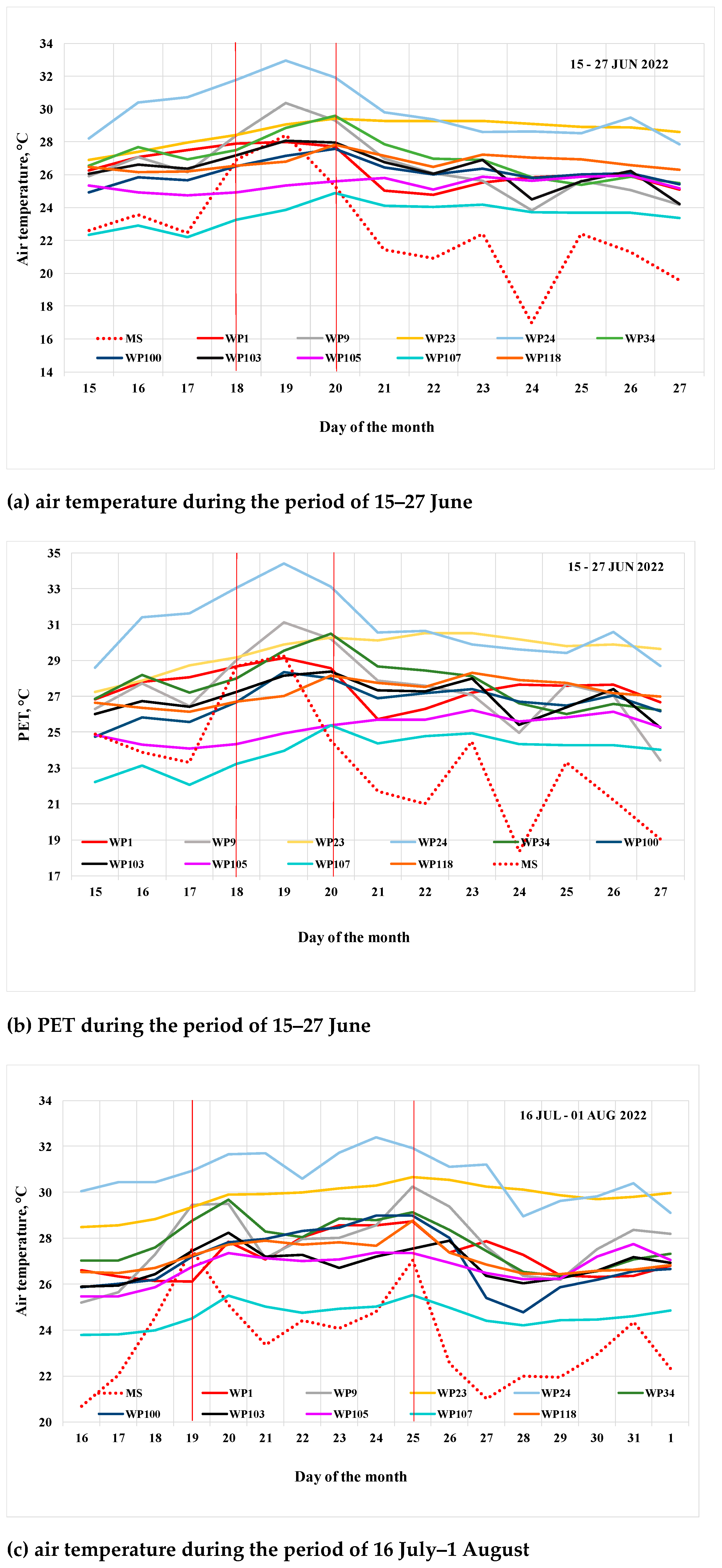
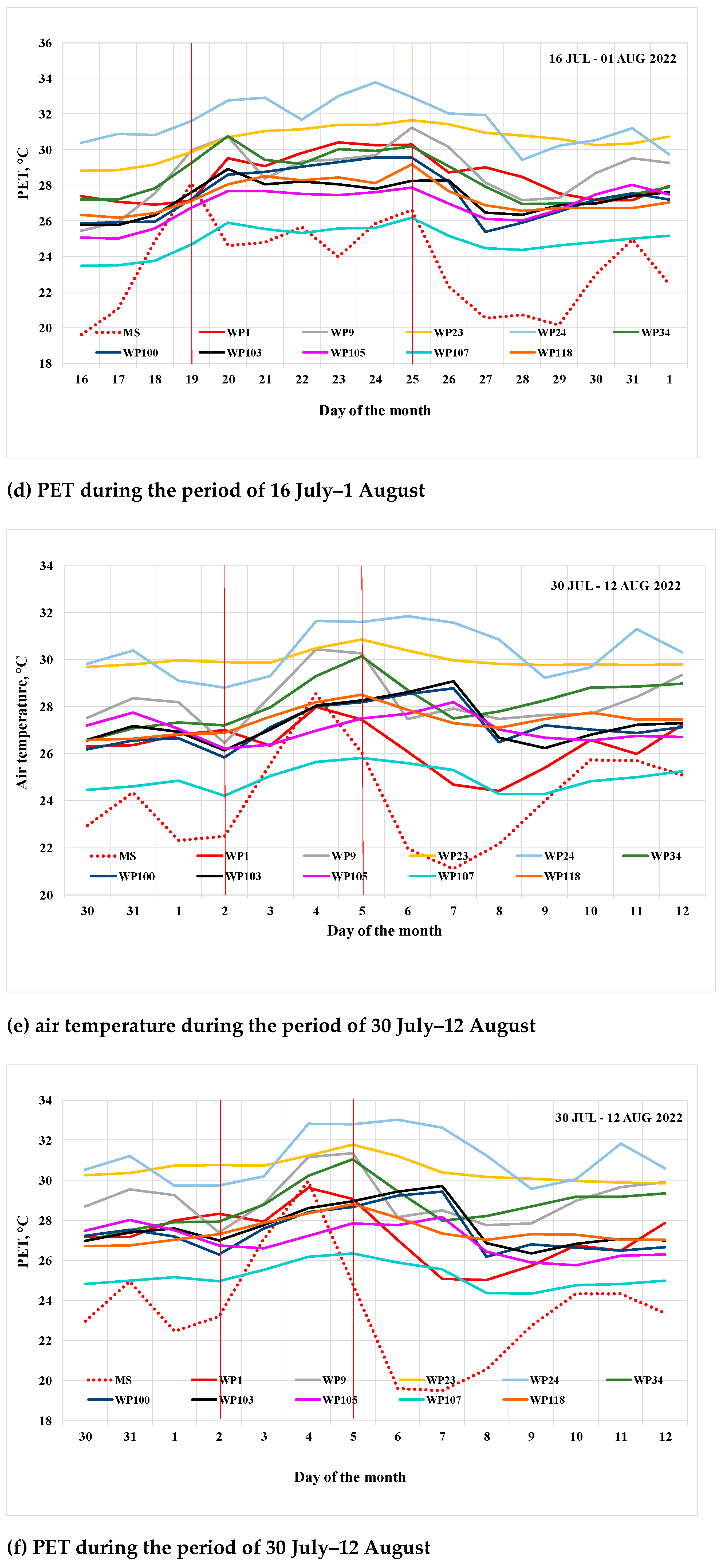
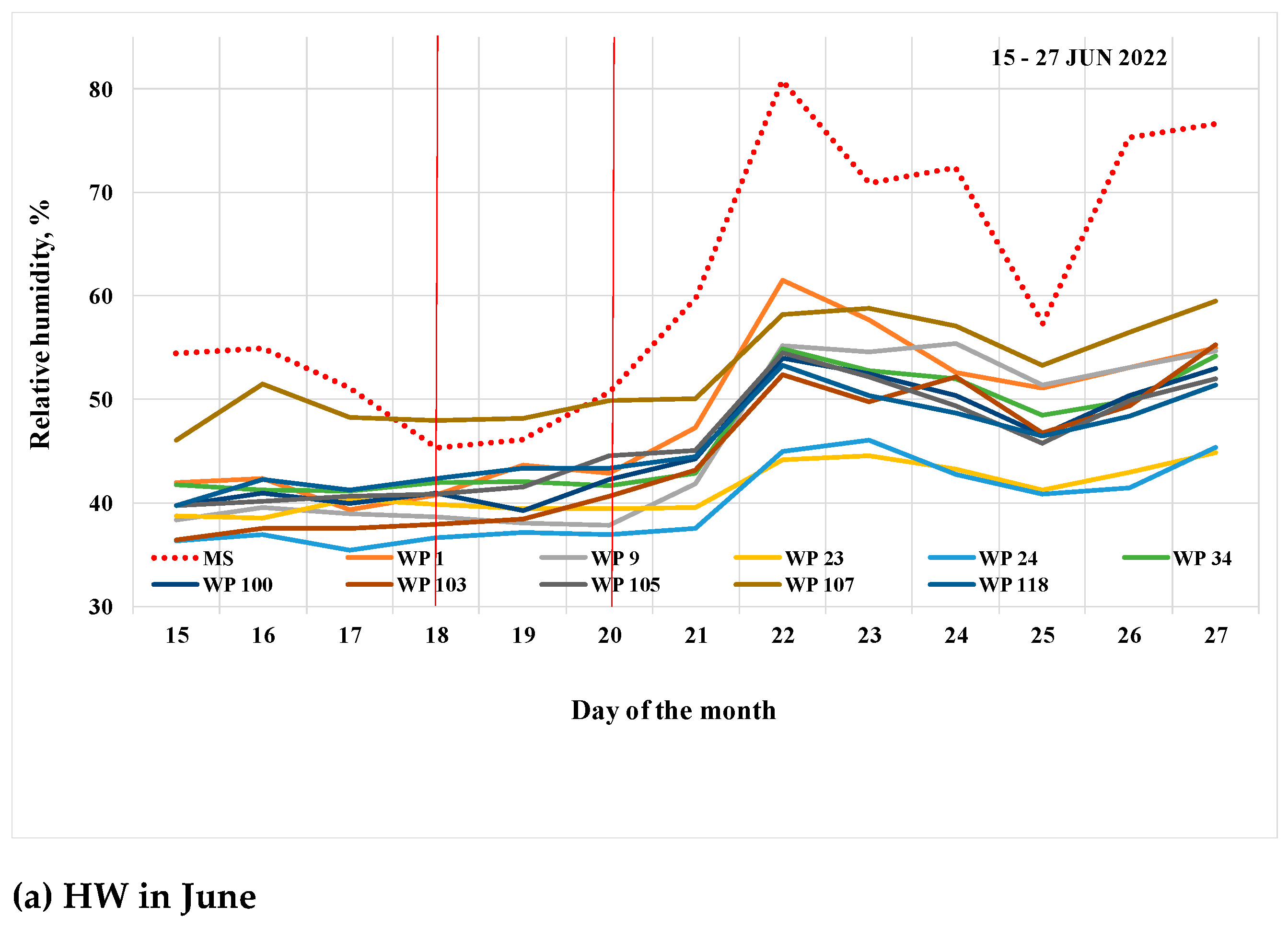



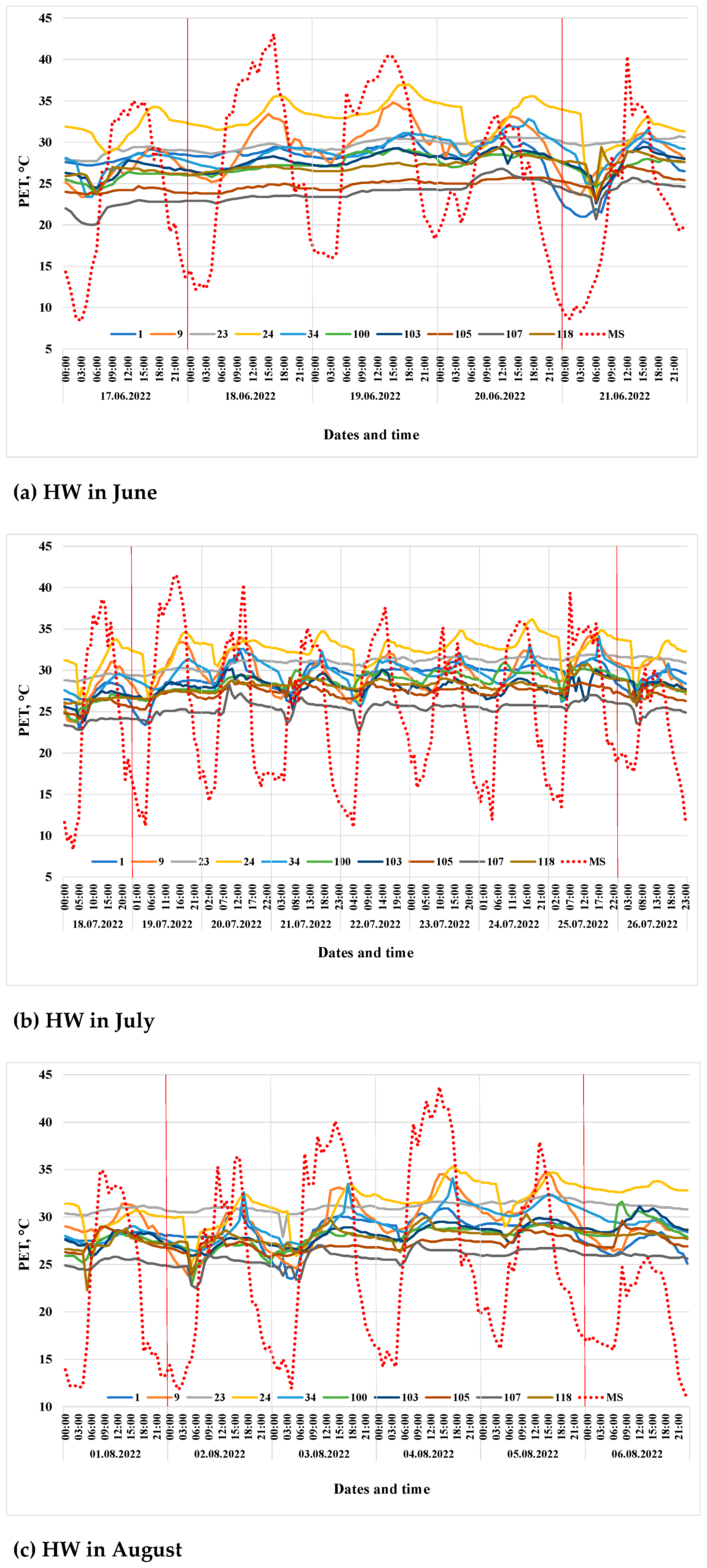
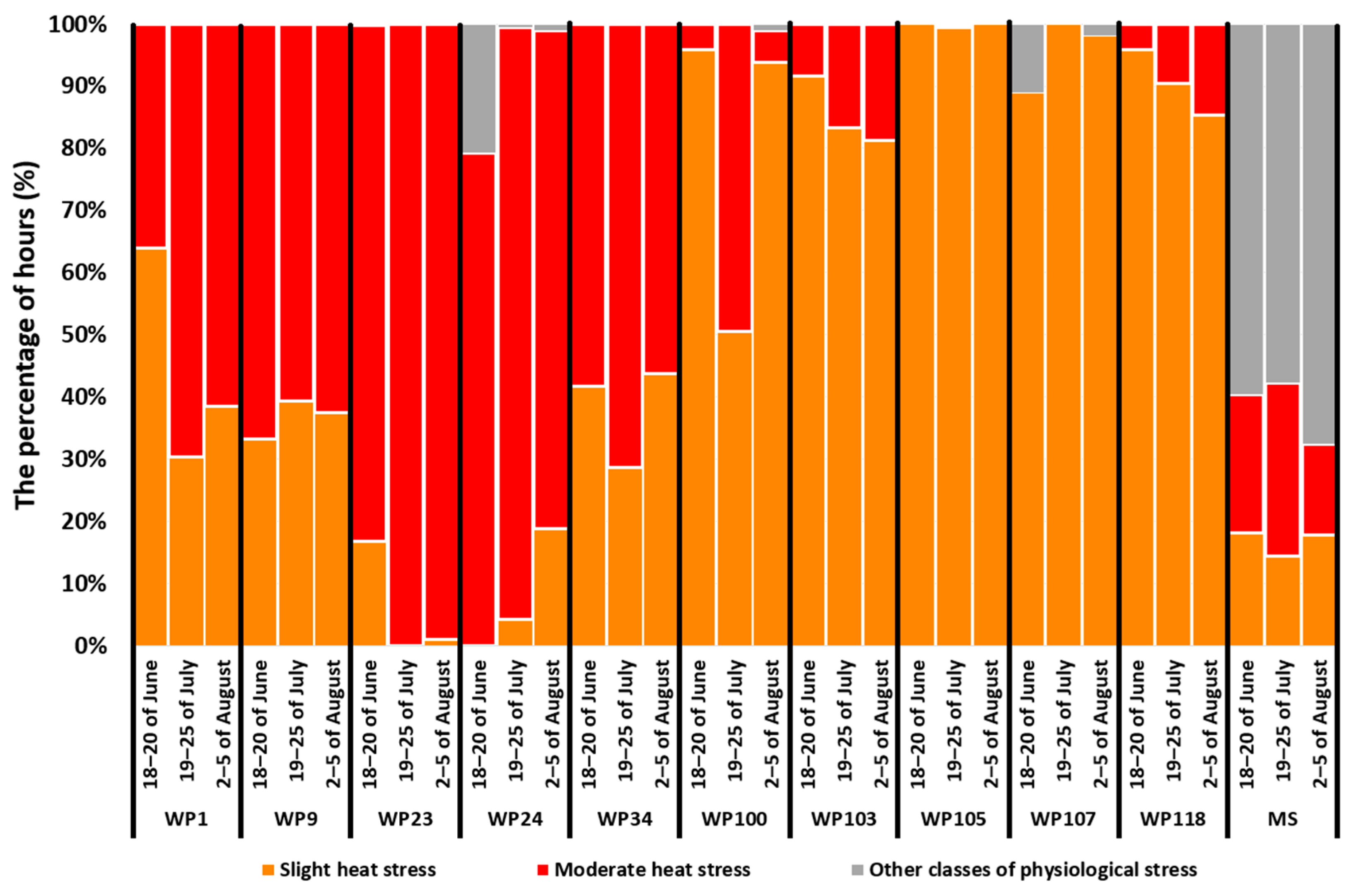
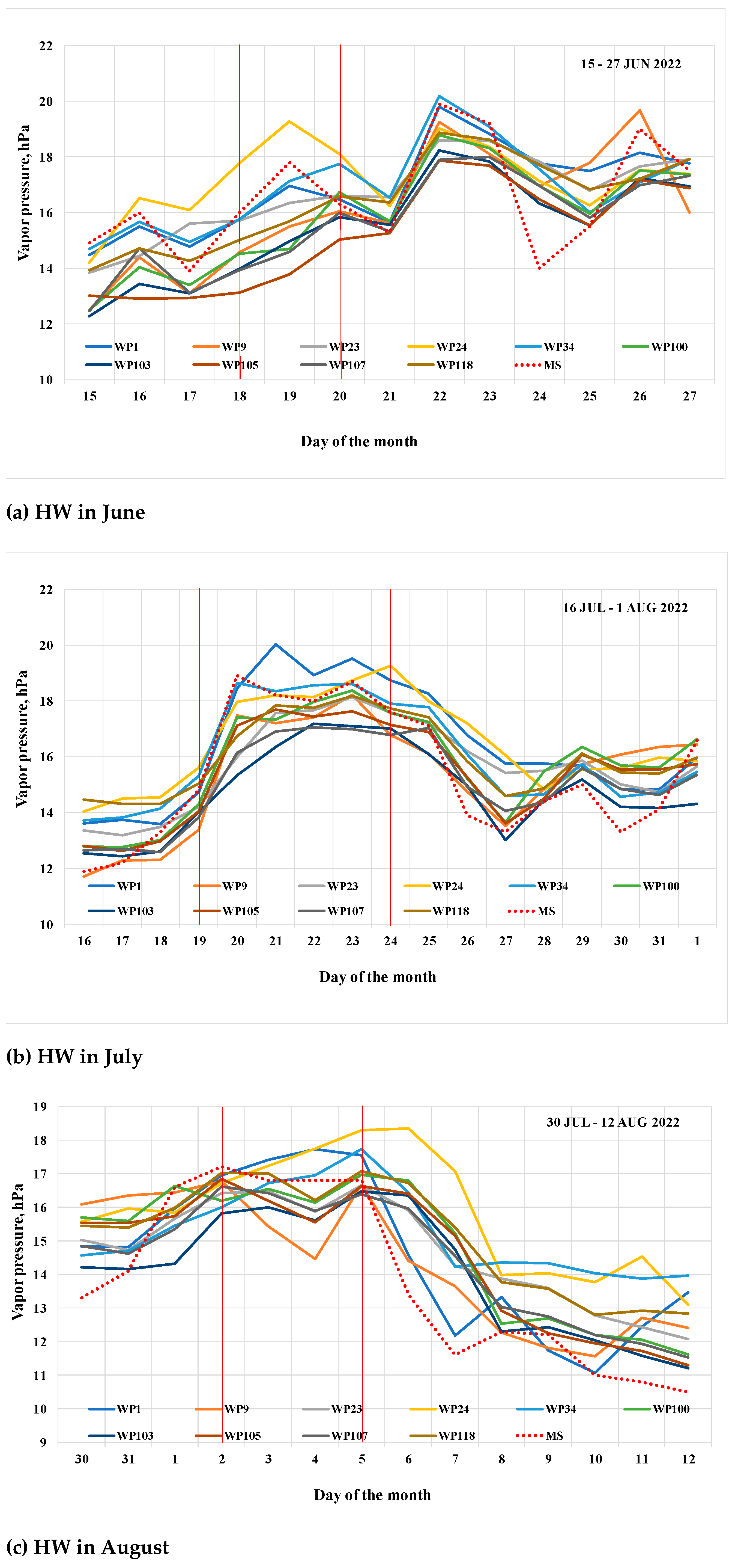


| Workplace_ID | 1 | 9 | 23 | 24 | 34 | 100 | 103 | 105 | 107 | 118 |
|---|---|---|---|---|---|---|---|---|---|---|
| Latitude | 47.977 | 48.001 | 48.004 | 48.000 | 47.993 | 48.001 | 48.001 | 48.001 | 48.001 | 47.993 |
| Longitude | 7.824 | 7.849 | 7.854 | 7.848 | 7.846 | 7.846 | 7.846 | 7.846 | 7.846 | 7.846 |
| Year of construction | 1990–2010 | 1950–1970 | 1900–1930 | 1950–1970 | 1900–1930 | 1970–1990 | 1970–1990 | 1970–1990 | 1970–1990 | 1900–1930 |
| Main building material | Concrete | Concrete | Stone | Concrete/Stone | Stone | Stone | Stone | Stone | Stone | Stone |
| Building height (floors) | 5 | 12 | 6 | 6 | 3 | 10 | 10 | 10 | 10 | 3 |
| Floor | 1 | 3 | 4 | 3 | 0 | 8 | 8 | 8 | Ground 0 | 0 |
| Room height (m) | 2.5 | 3.0 | 3.0 | 2.7 | 3.0 | 2.5 | 2.5 | 2.5 | 3.8 | 3.0 |
| Room size (m²) | 40 | 22 | 20 | 15 | 20 | 20 | 18 | 30 | 40 | 25 |
| Position of MoBiMet | Desk | Wall | Shelf | Shelf | Desk | Windowsill | Desk (near window) | Desk (middle of room) | Desk | Desk |
| Exposition of windows | N, W | S | ENE | W | SW | ESE | SSE | ESE, SSE | ESE | E |
| Direct solar radiation | False | True | Un-known | True | True | True | True | True | True | True |
| Shading | Unknown | Jalousie | None | Jalousie | Jalousie (outside) | Jalousie (outside) | Jalousie (outside) | Jalousie (outside) | Roller shutter/ curtain | Roller shutter |
| Air conditioning | False | False | False | False | False | False | False | False | True | False |
| PET, °C | Thermal Perception | Class of Physiological Stress |
|---|---|---|
| ˂4 | Very cold | Extreme cold stress |
| 4.1–8.0 | Cold | Strong cold stress |
| 8.1–13.0 | Cool | Moderate cold stress |
| 13.1–18.0 | Slightly cool | Slight cold stress |
| 18.1–23.0 | Comfortable | No thermal stress |
| 23.1–29.0 | Slightly warm | Slight heat stress |
| 29.1–35.0 | Warm | Moderate heat stress |
| 35.1–41.0 | Hot | Strong heat stress |
| ˃41.1 | Very hot | Extreme heat stress |
| Mean | Mean 09:00–18:00 UTC | Range (Max–Min) | |||||||||
|---|---|---|---|---|---|---|---|---|---|---|---|
| Ta, °C | PET, °C | RH, % | Diff. PET - Ta, °C | Ta, °C | PET, °C | RH, % | Diff. PET - Ta, °C | Ta, °C | PET, °C | RH, % | |
| WP1 | 26.0 | 27.1 | 45.9 | 1.1 | 26.7 | 27.8 | 45.6 | 1.1 | 9.6 | 12.7 | 47.3 |
| WP9 | 26.1 | 26.9 | 43.6 | 0.8 | 27.4 | 28.4 | 42.9 | 1.0 | 15.8 | 16.9 | 47.8 |
| WP23 | 28.4 | 29.1 | 38.8 | 0.7 | 28.6 | 29.3 | 38.8 | 0.7 | 7.0 | 7.6 | 24.8 |
| WP24 | 29.1 | 29.8 | 38.3 | 0.7 | 29.2 | 30.2 | 38.5 | 1.0 | 13.0 | 15.9 | 34.3 |
| WP34 | 26.8 | 27.3 | 43.5 | 0.5 | 27.2 | 27.9 | 43.6 | 0.7 | 10.0 | 13.3 | 37.3 |
| WP100 | 25.8 | 26.2 | 43.9 | 0.4 | 26.3 | 26.6 | 43.4 | 0.3 | 15.4 | 18.7 | 36.3 |
| WP103 | 26.1 | 26.6 | 42.4 | 0.5 | 26.8 | 27.2 | 42.3 | 0.4 | 12.7 | 12.8 | 38.4 |
| WP105 | 25.7 | 25.6 | 43.6 | −0.1 | 26.0 | 26.0 | 43.5 | 0.0 | 12.1 | 11.2 | 42.1 |
| WP107 | 23.7 | 23.9 | 49.5 | 0.2 | 23.9 | 24.3 | 49.6 | 0.4 | 8.9 | 11.2 | 46.0 |
| WP118 | 26.5 | 26.7 | 43.8 | 0.2 | 26.8 | 27.0 | 43.0 | 0.2 | 8.8 | 17.3 | 37.8 |
| MS | 21.9 | 21.9 | 58.7 | 0.0 | 26.2 | 28.7 | 43.7 | 2.5 | 29.0 | 39.8 | 84.8 |
| WP | No Thermal Stress | Slight Heat Stress | Moderate, Strong, and Extreme Heat Stress |
|---|---|---|---|
| WP1 | 2.9 | 82.8 | 14.2 |
| WP9 | 12.0 | 62.4 | 25.6 |
| WP23 | 0.0 | 46.3 | 53.7 |
| WP24 | 0.4 | 38.0 | 61.6 |
| WP34 | 0.8 | 80.8 | 18.4 |
| WP100 | 3.7 | 91.0 | 5.3 |
| WP103 | 3.0 | 91.5 | 5.5 |
| WP105 | 4.4 | 94.7 | 1.0 |
| WP107 | 26.9 | 73.1 | 0.0 |
| WP118 | 0.1 | 97.4 | 2.5 |
| MS | 18.3 | 20.1 | 22.6 |
| Air Temperature (°C) | Physiologically Equivalent Temperature (°C) | |||||
|---|---|---|---|---|---|---|
| HW 1 | HW 2 | HW 3 | HW 1 | HW 2 | HW 3 | |
| WP1 | 0.6626 | 0.4230 | 0.6861 | 0.6282 | 0.3004 | 0.5852 |
| WP9 | 0.8343 | 0.7772 | 0.7920 | 0.7137 | 0.6186 | 0.5946 |
| WP23 | 0.4169 | 0.2851 | 0.5181 | 0.3503 | 0.1510 | 0.3516 |
| WP24 | 0.4479 | 0.2481 | 0.2668 | 0.2280 | 0.0125 | 0.0372 |
| WP34 | 0.4817 | 0.4403 | 0.4988 | 0.2970 | 0.2092 | 0.2818 |
| WP100 | 0.6009 | 0.5374 | 0.5079 | 0.4075 | 0.3503 | 0.3398 |
| WP103 | 0.7683 | 0.5885 | 0.4810 | 0.4992 | 0.3783 | 0.2565 |
| WP105 | 0.3773 | 0.5568 | 0.4036 | 0.3238 | 0.5212 | 0.4428 |
| WP107 | 0.3297 | 0.3930 | 0.5134 | 0.2927 | 0.3107 | 0.5316 |
| WP118 | 0.3732 | 0.4966 | 0.6691 | 0.2753 | 0.3324 | 0.5108 |
Disclaimer/Publisher’s Note: The statements, opinions and data contained in all publications are solely those of the individual author(s) and contributor(s) and not of MDPI and/or the editor(s). MDPI and/or the editor(s) disclaim responsibility for any injury to people or property resulting from any ideas, methods, instructions or products referred to in the content. |
© 2025 by the authors. Licensee MDPI, Basel, Switzerland. This article is an open access article distributed under the terms and conditions of the Creative Commons Attribution (CC BY) license (https://creativecommons.org/licenses/by/4.0/).
Share and Cite
Shevchenko, O.; Sulzer, M.; Christen, A.; Matzarakis, A. Coupling Indoor and Outdoor Heat Stress During the Hot Summer of 2022: A Case Study of Freiburg, Germany. Atmosphere 2025, 16, 167. https://doi.org/10.3390/atmos16020167
Shevchenko O, Sulzer M, Christen A, Matzarakis A. Coupling Indoor and Outdoor Heat Stress During the Hot Summer of 2022: A Case Study of Freiburg, Germany. Atmosphere. 2025; 16(2):167. https://doi.org/10.3390/atmos16020167
Chicago/Turabian StyleShevchenko, Olga, Markus Sulzer, Andreas Christen, and Andreas Matzarakis. 2025. "Coupling Indoor and Outdoor Heat Stress During the Hot Summer of 2022: A Case Study of Freiburg, Germany" Atmosphere 16, no. 2: 167. https://doi.org/10.3390/atmos16020167
APA StyleShevchenko, O., Sulzer, M., Christen, A., & Matzarakis, A. (2025). Coupling Indoor and Outdoor Heat Stress During the Hot Summer of 2022: A Case Study of Freiburg, Germany. Atmosphere, 16(2), 167. https://doi.org/10.3390/atmos16020167








